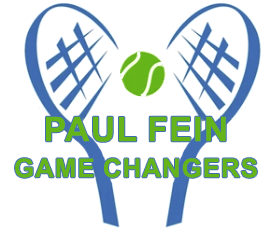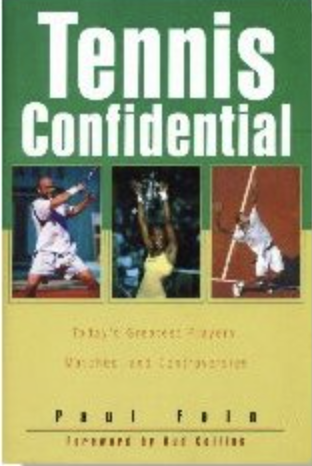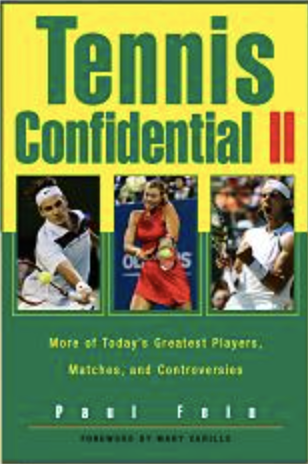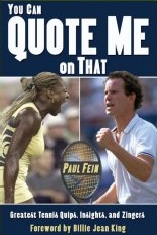What Does Baseball Have to Do with Tennis?
Hits: 65
“Tennis should be at the top of the list for sports with the greatest athletes. I’m in awe of what great athletes they are.”
– Retired baseball superstar Alex Rodriguez
Recently, Tennis Channel analyst Jimmy Arias, while calling a match, said, “I think baseball is the least relatable [sport] to tennis outside of the throwing motion making for a very good serve.”
I have long admired Jimmy as one of our sport’s smartest analysts on technique and tactics as well as for complicated, off-court tennis issues and controversies.
 However, I respectfully disagree with Jimmy’s assertion. Because this subject is so important, especially for young, aspiring players, The Fein Points of Tennis includes a chapter titled “How Playing Other Sports Benefits Your Tennis.” The consensus of experts is that basketball and soccer offer the greatest benefit for tennis players. But several other sports—such as ice hockey, skiing, track, badminton, table tennis, and boxing—also enhance various athletic abilities and skills and thus accelerate the learning curve for technique and tactics in tennis.
However, I respectfully disagree with Jimmy’s assertion. Because this subject is so important, especially for young, aspiring players, The Fein Points of Tennis includes a chapter titled “How Playing Other Sports Benefits Your Tennis.” The consensus of experts is that basketball and soccer offer the greatest benefit for tennis players. But several other sports—such as ice hockey, skiing, track, badminton, table tennis, and boxing—also enhance various athletic abilities and skills and thus accelerate the learning curve for technique and tactics in tennis.
What about baseball? Here are several ways that baseball, besides providing the ideal throwing motion for serves and overheads, can improve your tennis.
First, the slightly low-to-high baseball swing is quite similar to that used in tennis groundstrokes. And “grooving” both swings is vital in both sports.
Second, simply using an implement, such as a bat in baseball—something missing in basketball and soccer—to hit a small, fast-moving ball very much enhances one’s hand-eye coordination.
Third, as a former baseball center fielder, I know first-hand that sprinting for and catching 300-foot fly balls coming at varying speeds and trajectories made my moving back 20 feet for overheads quite easy when I switched to tennis.
Fourth, stealing bases in baseball requires the same explosive starts and excellent judgment you need in tennis.
Fifth, all nine baseball fielders have to be able to catch balls that pop up, and every position has to catch either line drives or throws. In addition to enhancing one’s hand-eye coordination, this act of catching is similar to the compact motion when you volley.
Sixth, when infielders catch the ball on a quick hop, that skill is similar in positioning and timing to the half volley in tennis.
Seventh, the strike zone is very important for pitchers and batters in baseball. Batters try their utmost to hit only pitches in the strike zone, and preferably in, or near, the center of the strike zone because their chances of getting a hit, especially an extra-base hit, are much greater there. Similarly, tennis players fare much better when they hit the ball in their strike zones. The major difference in tennis is that players “create” their ideal strike zones by accurately judging distances and aligning themselves properly.
Eighth, concentration is critical in both sports, particularly in one very similar situation. The top baseball batters epitomize great concentration, as do the great serve returners in tennis.
Ninth, baseball requires considerable agility both on the base paths and when fielding. Rundowns in baseball, in fact, require agility from both the base runners and the infielders.
Tenth, understanding and coping with the wind—which can vary in intensity and direction—is very important in both outdoor sports. Skill and experience are also needed for dealing with a bright sun in both sports.
Eleventh, balance is highly important in baseball, especially when batting, but also when running and fielding. Watch a slick-fielding shortstop sprint deep “into the hole,” catch a hard-hit ground ball, and then regain enough balance to throw a bullet to nip the runner at first base. That is a thing of athletic and balletic beauty akin to dazzling running passing shots by Djokovic, Nadal, and Federer. In both sports, these athletic feats require superb balance.
Twelfth, quick reactions and reflexes are essential in both sports. In baseball, the first-baseman and third-baseman must somehow catch, or at least block, 100-mph line drives from a batter only 90 feet away. Similarly, tennis receivers must somehow return 130-mph first serves from 80 or 90 feet away.
Thirteenth, the sacrifice bunt has much in common with the drop volley in tennis. Both require a softer grip and a shorter forward motion in order to “deaden” the ball. In both cases, only some pro players possess the requisite "touch."
Fourteenth, leaping for balls in baseball is much like that in tennis. Think of a shortstop diving laterally to catch a line drive and a net-rusher diving to volley a tough passing shot. Also, an infielder or an outfielder jumping as high as possible to catch a line drive closely resembles a net-man leaping to smash a deep lob.
Fifteenth, one of the cardinal precepts in both sports is “Keep your eyes on the ball.” Boston Red Sox shortstop Xander Bogaerts, one of the best hitters in baseball, watches the oncoming pitch all the way until it goes into the catcher’s mitt. Similarly, all-time great Roger Federer watches the oncoming tennis ball until it hits the strings on his racket.
Sixteenth, a chapter in The Fein Points of Tennis is titled “Variety and Deception in Serving.” In short, the best baseball pitchers cleverly mix up their pitches—fastballs, curves, sliders, knuckleballs, etc.—to confound batters. It’s no coincidence that many of the best servers in tennis history, most notably Roger Federer and Serena Williams, effectively vary the speed, spin, and placement of their serves to keep serve returners confused and off-balance.
Have I missed any other pertinent and relatable athletic parallels between baseball and tennis? If so, feel free to email me at



